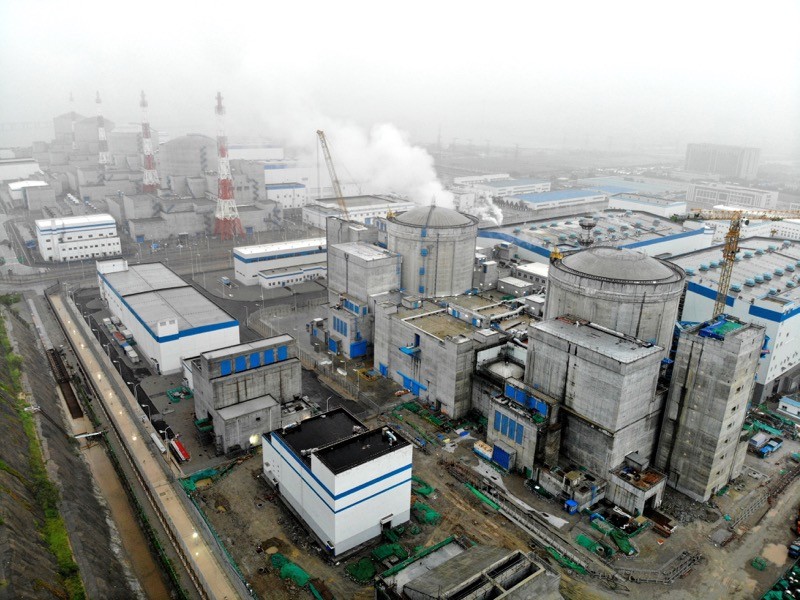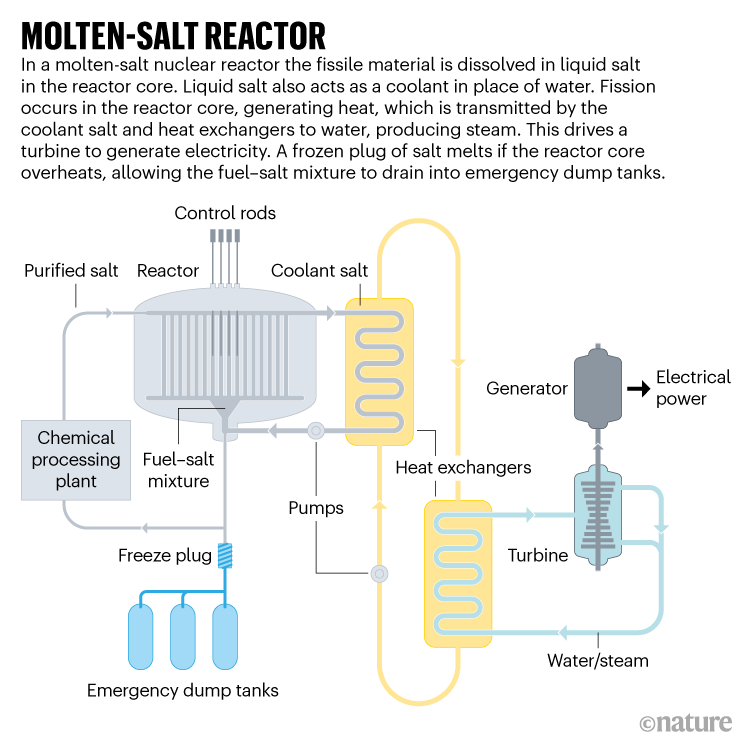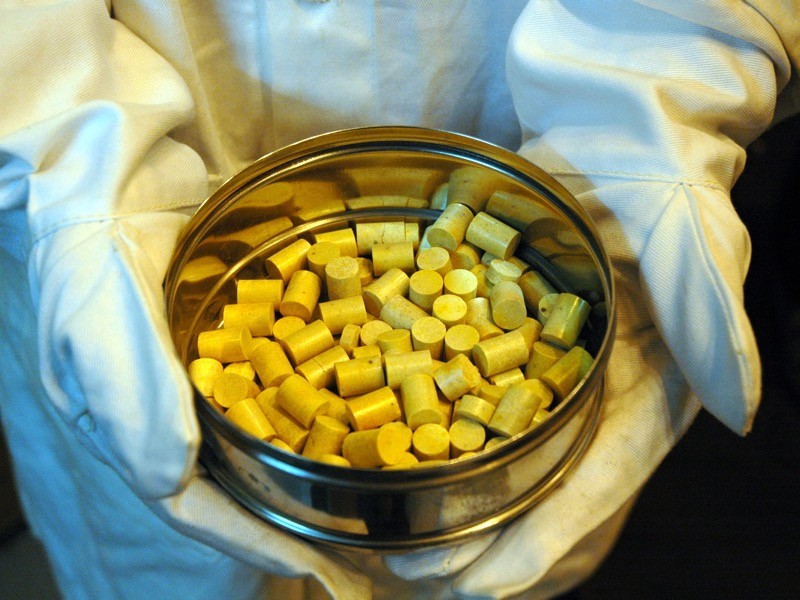- Shared by The Red Enviromentalist to China Environment on FB from Nature, 10 Sept 2021. Original Nature article shared here.
If China’s experimental reactor is a success it could lead to commercialization and help the nation (and the world) meet its climate goals.

Scientists are excited about an experimental nuclear reactor using thorium as fuel, which is about to begin tests in China. Although this radioactive element has been trialled in reactors before, experts say that China is the first to have a shot at commercializing the technology.
The reactor is unusual in that it has molten salts circulating inside it instead of water. It has the potential to produce nuclear energy that is relatively safe and cheap, while also generating a much smaller amount of very long-lived radioactive waste than conventional reactors.
Construction of the experimental thorium reactor in Wuwei, on the outskirts of the Gobi Desert, was due to be completed by the end of August — with trial runs scheduled for this month, according to the government of Gansu province.
Thorium is a weakly radioactive, silvery metal found naturally in rocks, and currently has little industrial use. It is a waste product of the growing rare-earth mining industry in China, and is therefore an attractive alternative to imported uranium, say researchers.
Powerful potential
“Thorium is much more plentiful than uranium and so it would be a very useful technology to have in 50 or 100 years’ time,” when uranium reserves start to run low, says Lyndon Edwards, a nuclear engineer at the Australian Nuclear Science and Technology Organisation in Sydney. But the technology will take many decades to realize, so we need to start now, he adds.
China launched its molten-salt reactor programme in 2011, investing some 3 billion yuan (US$500 million), according to Ritsuo Yoshioka, former president of the International Thorium Molten-Salt Forum in Oiso, Japan, who has worked closely with Chinese researchers.
Operated by the Shanghai Institute of Applied Physics (SINAP), the Wuwei reactor is designed to produce just 2 megawatts of thermal energy, which is only enough to power up to 1,000 homes. But if the experiments are a success, China hopes to build a 373-megawatt reactor by 2030, which could power hundreds of thousands of homes.
These reactors are among the “perfect technologies” for helping China to achieve its goal of zero carbon emissions by around 2050, says energy modeller Jiang Kejun at the Energy Research Institute of the National Development and Reform Commission in Beijing.
The naturally occurring isotope thorium-232 cannot undergo fission, but when irradiated in a reactor, it absorbs neutrons to form uranium-233, which is a fissile material that generates heat.
Thorium has been tested as a fuel in other types of nuclear reactor in countries including the United States, Germany and the United Kingdom, and is part of a nuclear programme in India. But it has so far not proved cost effective because it is more expensive to extract than uranium and, unlike some naturally occurring isotopes of uranium, needs to be converted into a fissile material.
Some researchers support thorium as a fuel because they say its waste products have less chance of being weaponized than do those of uranium, but others have argued that risks still exist.

Blast from the past
When China switches on its experimental reactor, it will be the first molten-salt reactor operating since 1969, when US researchers at the Oak Ridge National Laboratory in Tennessee shut theirs down. And it will be the first molten-salt reactor to be fuelled by thorium. Researchers who have collaborated with SINAP say the Chinese design copies that of Oak Ridge, but improves on it by calling on decades of innovation in manufacturing, materials and instrumentation.
Compared with light-water reactors in conventional nuclear power stations, molten-salt reactors operate at significantly higher temperatures, which means they could generate electricity much more efficiently, says Charles Forsberg, a nuclear engineer at Massachusetts Institute of Technology in Cambridge.
China’s reactor will use fluoride-based salts, which melt into a colourless, transparent liquid when heated to about 450 ºC. The salt acts as a coolant to transport heat from the reactor core. In addition, rather than solid fuel rods, molten-salt reactors also use the liquid salt as a substrate for the fuel, such as thorium, to be directly dissolved into the core.
Molten-salt reactors are considered to be relatively safe because the fuel is already dissolved in liquid and they operate at lower pressures than do conventional nuclear reactors, which reduces the risk of explosive meltdowns.
Yoshioka says many countries are working on molten-salt reactors — to generate cheaper electricity from uranium or to use waste plutonium from light-water reactors as fuel — but China alone is attempting to use thorium fuel.

Next-generation reactors
China’s reactor will be “a test bed to do a lot of learning”, says Forsberg, from analysing corrosion to characterizing the radionucleotide composition of the mixture as it circulates.
“We are going to learn so much new science,” agrees Simon Middleburgh, a nuclear materials scientist at Bangor University, UK. “If they would let me, I’d be on the first plane there.”
It could take months for China’s reactor to reach full operation. “If anything along the way goes wrong, you can’t continue, and have to stop and start again,” says Middleburgh. For example, the pumps might fail, pipes could corrode or a blockage might occur. Nevertheless, scientists are hopeful of success.
Molten-salt reactors are just one of many advanced nuclear technologies China is investing in. In 2002, an intergovernmental forum identified six promising reactor technologies to fast-track by 2030, including reactors cooled by lead or sodium liquids. China has programmes for all of them.
Some of these reactor types could replace coal-fuelled power plants, says David Fishman, a project manager at the Lantau Group energy consultancy in Hong Kong. “As China cruises towards carbon neutrality, it could pull out [power plant] boilers and retrofit them with nuclear reactors.”
Source: Nature, 10 Sept 2021
Leave a Reply
You must be logged in to post a comment.